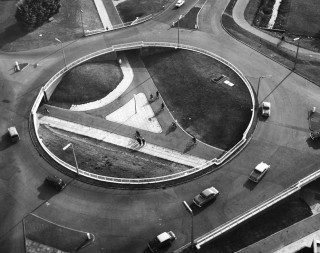Mr Lenthall on the conscious and subconscious reasons for pedestrian behaviour in Stevenage
Mr Lenthall looks at the reasons for pedestrian behaviour, assessing both the conscious and subconsious reasons for this
Stevenage Museum

Mr Lenthall talks about the conscious reasons for why pedestrians act the way they do- the answer is simple: distraction

Mr Lenthall discusses the subconscious reasons for pedestrian behaviour and connects it back to our ancient ancestors and the instinct for hunting
Transcript:
Now these were ordinary people, you and I so to speak, and this fascinated us, and we wondered what was this extraordinary compulsion that made them walk, behave in this way. And so we looked at our other films, and we discovered many characteristics like this, and the only way we could understand it was by creating a hypothesis – it is only a hypothesis because it’s not been investigated in great depth – that when people are on the move, they are subject to two different sets of controls. There’s the conscious control; if you’re driving along the road and somebody shouts hard at you and you hear it, that’s something which produces a reaction from you, or another motorist sounds his horn at you, and that produces a reaction from you. And there’s the subconscious control, and from talks we’ve had with other people we realise that most people on the move are subject to great many distractions. If you watch pedestrians moving along, they pay very little attention to exactly where they’re going. They’re much more interested in what is going on around them, and if they’re travelling in numbers, then they’re much more interested in conversations which they have with their fellow travellers. So that the conscious contribution is a very limited one.
Lenthall 1986
Transcript:
We then began to look at the subconscious contribution, and this was the piece of machinery that was making these people behave in such a determined and peculiar way. And we talked to various people there, including professors of physiology and psychology and people like this. We even went down to the Hendon police driving school to see what they had to say about human movement, learnt a great deal from them, and we came back and felt that what was happening here was something that went right back into human evolution. What was the mechanism which every human being has for moving around? And it seemed to us that man had been a hunter for so many years that this was playing a part. If you take, for instance, the eye-brain mechanism, if you take the eye mechanism most of the field of vision is not very clear, but it’s very very sensitive to movement. There is only a very narrow cone of vision in front of you where you can actually see clearly. Now that piece of mechanism is designed to pick up movement over a very wide area, and once it detects movement, then the head turns and the cone of clear vision focuses on the movement and identifies it. And that’s the sort of piece of sort of machinery that a hunting creature needs, because food is, is live, and movement was food, and so anything that moved had to be identified to see whether it was food or whether it was a danger, and if it was food then you chased it. And once you’d identified your target, so to speak, then you kept your head turned towards it so that you got this cone of clear vision keeping your quarry in view. And you set out after your food and then you began to meet all sorts of obstacles on the way and you learnt very quickly what was an obstacle and what wasn’t. A stream wasn’t an obstacle ‘cause you jumped over it. A bush wasn’t an obstacle ‘cause you run and pushed your way through it. And it was these sorts of characteristics we were seeing on people moving around still, you see.
Lenthall 1986









No Comments
Add a comment about this page